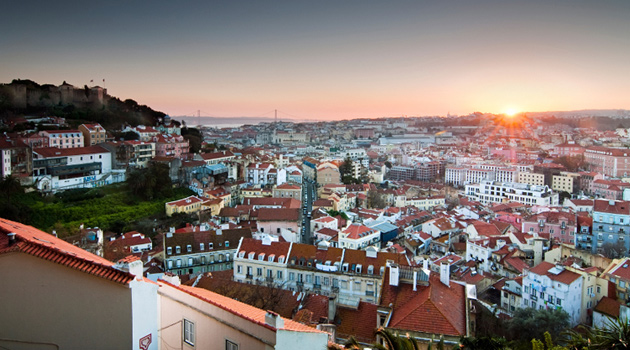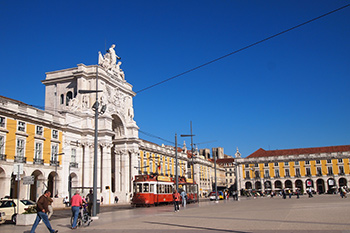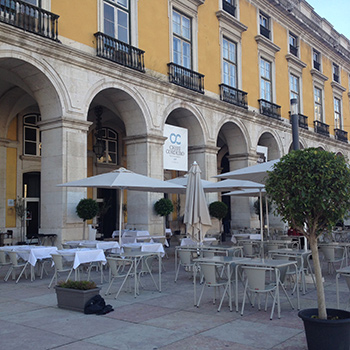
A city known for its charming cobblestone streets, tiled façades, cable cars and unpretentious atmosphere, Lisbon offers visitors a wealth of reasons to fall in love with the place. Located on the western coast of Portugal, Lisbon has been the capital since the 13th century. Its port on the Tagus River, marked by the Belém Tower, was once the spot from where all great world explorers would set sail. Lisbon is the perfect locale to explore for a weekend, but before you go, here are the top things to see and do, plus where to eat, drink and stay, to ensure you get the most out of your trip.
Day One
Right near Eduardo VII Park, the 282-room Four Seasons Hotel Ritz Lisboa is one of the city’s stalwart hotels, boasting a spa, a heated indoor pool and Lisbon’s largest private collection of contemporary Portuguese art. Or check into the city’s newest luxury bed and breakfast, Casa Amora. Located in the Praça das Amoreiras neighborhood, this inn, which opened in summer 2012, dons a distinctly warm contemporary Portuguese style. With just six rooms, Casa Amora can give you personalized hospitality and service. The lovely cook, Nita, will make a light breakfast, such as homemade banana bread and jam, and there is an honor bar, fresh fruit and homemade cookies available throughout the day. Plus, after a long day of walking around those hilly cobblestone streets, those luscious beds are all you’ll be thinking about.
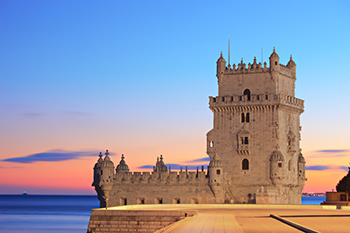 Spend the morning riding around town — either by scooter (we suggest renting one through Lisbon Vintage Scooter) or cable car — and make your way down to Belém, a district just west of the city center. The Belém Tower is an impressive monument, and you will have a view of where the Atlantic Ocean meets the Tagus River. While there, you must try the famous pasteis de Belém, a creamy, flaky, hot pastry typical to the region. These pastries make great presents to take home as well.
Spend the morning riding around town — either by scooter (we suggest renting one through Lisbon Vintage Scooter) or cable car — and make your way down to Belém, a district just west of the city center. The Belém Tower is an impressive monument, and you will have a view of where the Atlantic Ocean meets the Tagus River. While there, you must try the famous pasteis de Belém, a creamy, flaky, hot pastry typical to the region. These pastries make great presents to take home as well.
After touring Belém, head up to the historic Alfama district around the Lisbon Cathedral, where you can happily get lost exploring the art galleries, shops, restaurant patios and churches.
When it comes time for lunch, hop over to the Praça do Comércio, the large square along the water that’s lined with restaurants and bars, and has live music ringing through the air. Here, you’ll find Chefe Cordeiro restaurant from acclaimed chef José Cordeiro. Claim a spot outside in the sunshine and enjoy everything from snacks to elaborate gastronomic dishes inspired by the region.
After lunch, venture to the area of town called Príncipe Real, near the botanical gardens. You’ll find shopping galore, including one of Lisbon’s hottest concept stores, Embaixada. Each room of this former embassy is a different boutique and highlights a young or up-and-coming Portuguese designer. Peruse everything from home goods to clothes, beauty products and jewelry — there’s even an in-house café and bar.
For dinner, it’s time you had some of the famous Portuguese seafood. One of the most iconic seafood houses is Solar dos Presuntos, whose walls are lined with pictures of celebrities who have dined at the restaurant in the last 40 years. The specialties of the house are the fresh fish dishes; but the lobster-and-prawn paella is another must-try. In restaurants such as this, it’s important to know that if you eat the food set out for you on the table before you arrive, you will likely be charged. Traditional Portuguese eateries often leave bread, olives, cheese and ham on the table, but you are in no way obligated to keep them. But one thing you will want to have is the Azeitão sheep cheese. It is one of the best we tried in Lisbon, with a delicious creamy, tangy flavor. For a pairing, look at the restaurant’s extensive wine list on an iPad. Among the more than 500 selections, try a classic Portuguese vinho verde.
If you are in the mood for a libation after dinner, head to the Cinco Lounge, which makes the best cocktails in Lisbon (try Jingle Bell Batman Smells with Wray and Nephew rum, cognac and black raspberry liqueur) and also conducts mixology classes. Or venture to the Pavilhão Chinês (Chinese Pavilion) bar around the corner, which is known as a kitsch lover’s goldmine, thanks to its endless array of toy soldiers, figurines and the like.
Pass the morning at one of the museums, such as Museu da Água (“the water museum”), which has an incredible view of all of Lisbon and details the history of the famous aqueducts built here in the 18th century. Make your way up to the Castelo de São Jorge before lunch and enjoy 360-degree panoramas from one of the highest points in the city. This castle, which archaeologists have dated back to as far as 2nd century B.C., was used by everyone from the Romans and Greeks to the Moorish people during the Christian Reconquista. The castle was severely damaged in 1755 after the Lisbon earthquake. Today, huge trees peeking above the red clay rooftops of the city shade the castle’s ruins and visitors alike.
While you’re in the seafood capital, there is one thing you can’t leave here without trying: the pregos no pão (steak sandwiches) at Cantinho do Avillez in the Chiado neighborhood. It is by far one of Lisbon’s best local dishes. Each chef at the traditional petiscos (tapas) restaurants has a version of this sandwich, but chef José Avillez takes it a step further. He adds a rich garlic butter sauce that melts between the freshly baked bread and top-quality meat, then serves the sandwich in a mini cast-iron skillet. Cantinho do Avillez also does other versions of the dish, featuring avocado and salsa, and even a vegetarian option. The 35-year-old Avillez has been trained by chefs such as Alain Ducasse, Éric Fréchon and, most importantly to him, Ferran Adrià at El Bulli. Cantinho do Avillez is one of Lisbon’s hottest tables, and is open for lunch and dinner.
“Cantinho do Avillez is an old wish of mine,” Avillez says. “For a long time, I have dreamt of a restaurant like this one: a relaxed and comfortable atmosphere with a simple but sophisticated cuisine, which makes us want to return and return.”
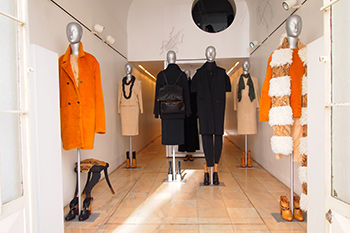 After lunch, head to the Bario Alto neighborhood to walk around and window-shop. In the late afternoon, there is no better place to unwind than at Park, Lisbon’s coolest rooftop bar on top of a parking garage. With views of the Tagus River, the 25 de Abril bridge and the enormous Christ the King statue across the river, the sunsets seen from Park are breathtaking. The lounge serves bites (juicy burgers) and delicious cocktails (sangria made with prosecco and fresh berries), as well as the traditional Super Bock beer found throughout the city. At night, it often features local DJs and the parties run into the wee hours of the morning.
After lunch, head to the Bario Alto neighborhood to walk around and window-shop. In the late afternoon, there is no better place to unwind than at Park, Lisbon’s coolest rooftop bar on top of a parking garage. With views of the Tagus River, the 25 de Abril bridge and the enormous Christ the King statue across the river, the sunsets seen from Park are breathtaking. The lounge serves bites (juicy burgers) and delicious cocktails (sangria made with prosecco and fresh berries), as well as the traditional Super Bock beer found throughout the city. At night, it often features local DJs and the parties run into the wee hours of the morning.
Keep the evening going with an aperitivo at The Old Pharmacy, one of Lisbon’s best wine bars, on the quaint Rua do Diário de Notícias. The staff is incredibly helpful when navigating the uncharted territory of Portuguese wines. While most Portuguese reds are quite high in alcohol content and heavy on the tannins, there are a few that are lighter, and similar, for example, to a Côtes du Rhône from France. If this is your style, try a Portuguese Dão, full bodied but not too heavy or dry. The bar has a nice selection of light, crisp vinho verdes as well, and a list of cheese and ham plates to curb your hunger.
To cap off your evening in Lisbon, head to a fado bar, where the nostalgic music of old Portugal has seen a revival in recent years thanks to young singers passionate about keeping the art alive. The most authentic fado music in Lisbon is found in the Alfama neighborhood, just off of the coast of the Tagus. Check out Clube de Fado or Parreirinha de Alfama. Or see the famous Ana Marina sing in the small and friendly Sr. Fado in the same area.
Photos Courtesy of iStock and Lindsay McCallum
